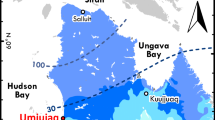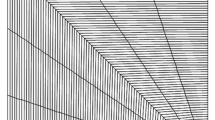Abstract
The paper deals with numerical computations of hydraulic variations and groundwater flow changes in continuous permafrost due to climate change and open-pit mining in the cold regions of Northern Canada. The work is a case study in connection with the proposed Kiggavik project in Nunavut, Canada. A major challenge in simulating fluid flow through partially frozen porous media is how to define the transient hydraulic conductivity as a function of temperature. An indirect approach based on the similarity between soil freezing and soil–water characteristic curves for unsaturated soils is implemented to define the relation between unfrozen water content and cryogenic suction which is linked to temperature by the Clausius–Clapeyron equation. Richard’s equation is then used to model fluid flow in partially frozen ground conditions. Finite element numerical modelling results of a worst-case climate change scenario indicate that although the permafrost could disappear completely in about 750 years with an increase in \(7\,^{\circ }\)C in the mean annual ground surface temperature during the next 100 years, the groundwater level around tailings facility would be approximately 35 m below ground surface. Hence, tailings pore water would not likely to migrate upwards to reach the ground surface even after the permafrost is completely disappeared. These conclusions are certainly within uncertainties and limitations of the analysis.

























Similar content being viewed by others
References
Andersland OB, Ladanyi B (2004) Frozen ground engineering. Wiley, New York
Anderson DM, Hoekstra P (1965) Migration of interlamellar water during freezing and thawing of Wyoming bentonite. Soil Sci Soc Am J 29(5):498–504
Areva Resources Canada Inc. (2014) Kiggavik project final environmental impact statement
Azmatch TF, Sego DC, Arenson LU, Biggar KW (2012) Using soil freezing characteristic curve to estimate the hydraulic conductivity function of partially frozen soils. Cold Reg Sci Technol 83:103–109
Bense VF, Ferguson G, Kooi H (2009) Evolution of shallow groundwater flow systems in areas of degrading permafrost. Geophys Res Lett 36:L22401. https://doi.org/10.1029/2009GL039225
Brooks RH, Corey AT (1966) Properties of porous media affecting fluid flow. J Irrig Drain Div 92(2):61–90
Burn CR (1992) Recent ground warming inferred from the temperature in permafrost near Mayo, Yukon territory. In: Dixon JC, Abrahams AD (eds) Periglacial geomophology. Wiley, Chichester, England, pp 327–350
Burn CR (1998) Field investigations of permafrost and climatic change in Northwest North America. In: Proceedings of seventh international conference on Permafrost. pp 107–120
COMSOL Multiphysics® v. 5.3. COMSOL AB, Stockholm, Sweden. https://www.comsol.com
Davis EH, Raymond GP (1965) A non-linear theory of consolidation. Geotechnique 15(2):161–173
Delisle G (1998) Numerical simulation of permafrost growth and decay. J Quat Sci 13(4):325–333
Dirksen C, Miller RD (1966) Closed-system freezing of unsaturated soil. Soil Sci Soc Am J 30(2):168–173
Edwards MP, Hill JM, Selvadurai APS (2008) Lie group symmetry analysis of transport in porous media with variable transmissivity. J Math Anal Appl 341(2):906–921
Faghri A, Zhang Y (2006) Transport phenomena in multiphase systems. Academic Press, Cambridge
Fredlund DG, Xing A (1994) Equations for the soil-water characteristic curve. Can Geotech J 31(4):521–532
Gibson RE, England GL, Hussey MJL (1967) The theory of one-dimensional consolidation of saturated clays: 1. Finite non-linear consolidation of thin homogeneous layers. Geotechnique 17(3):261–273
Guymon GL, Luthin JN (1974) A coupled heat and moisture transport model for arctic soils. Water Resour Res 10(5):995–1001
Halsey LA, Vitt DH, Zoltai SC (1995) Disequilibrium response of permafrost in boreal continental western Canada to climate change. Clim Change 30(1):57–73
Harlan RL (1973) Analysis of coupled heat-fluid transport in partially frozen soil. Water Resour Res 9(5):1314–1323
Hartikainen J (2006) Numerical simulation of permafrost depth at Olkiluoto. Working Report, vol. 52
Hayashi M (2014) The cold vadose zone: hydrological and ecological significance of frozen-soil processes. Vadose Zone J 13(1):01
Hoekstra P (1966) Moisture movement in soils under temperature gradients with the cold-side temperature below freezing. Water Resour Res 2(2):241–250
Horiguchi K, Miller RD (1983) Hydraulic conductivity functions of frozen materials. In: Proceedings of 4th international conference on Permafrost. pp 504–508
Intergovernmental Panel on Climate Change (2014) Climate change 2014-impacts, adaptation and vulnerability: regional aspects. Cambridge University Press, Cambridge
Jame Y-W, Norum DI (1980) Heat and mass transfer in a freezing unsaturated porous medium. Water Resour Res 16(4):811–819
Jumikis AR (1966) Thermal soil mechanics. Rutgers University Press, New Brunswick
Kemper WD (1960) Water and ion movement in thin films as influenced by the electrostatic charge and diffuse layer of cations associated with clay mineral surfaces. Soil Sci Soc Am J 24(1):10–16
Kinosita S (1975) Soil–water movement and heat flux in freezing ground. In: Proceedings conference on soil water problems in Cold regions
Konrad J-M, Morgenstern NR (1980) A mechanistic theory of ice lens formation in fine-grained soils. Can Geotech J 17(4):473–486
Koopmans RW, Miller RD (1966) Soil freezing and soil water characteristic curves. Soil Sci Soc Am J 30(6):680–685
Krogh SA, Pomeroy JW (2018) Recent changes to the hydrological cycle of an arctic basin at the tundra-taiga transition. Hydrol Earth Syst Sci 22(7):3993–4014
Lachenbruch AH, Marshall BV (1986) Changing climate: geothermal evidence from permafrost in the Alaskan Arctic. Science 234(4777):689–696
Liu Z, Yu X (2011) Coupled thermo–hydro–mechanical model for porous materials under frost action: theory and implementation. Acta Geotech 6(2):51–65
Mallants D (2006) Basic concepts of water flow, solute transport, and heat flow in soils and sediments. Belgium 17:169–183
McBean G (2004) Arctic climate: past and present, Chapter 2. Cambridge University Press, Cambridge
Mottaghy D, Rath V (2006) Latent heat effects in subsurface heat transport modelling and their impact on palaeotemperature reconstructions. Geophys J Int 164(1):236–245
Nakano Y, Brown J (1972) Mathematical modeling and validation of the thermal regimes in tundra soils, Barrow, Alaska. Arct Alp Res 4(1):19–38. https://doi.org/10.1080/00040851.1972.12003667
Newman GP, Wilson GW (1997) Heat and mass transfer in unsaturated soils during freezing. Can Geotech J 34(1):63–70
Nishimura S, Gens A, Olivella S, Jardine RJ (2009) Thm-coupled finite element analysis of frozen soil: formulation and application. Geotechnique 59(3):159
Noetzli J, Gruber S (2009) Transient thermal effects in alpine permafrost. The Cryosphere 3(1):85–99
Ortenblad A (1930) Mathematical theory of the process of consolidation of mud deposits. J Math Phys 9(1):73–149
Outcalt SI (1976) A numerical model of ice Lensing in freezing soils. In: Proceedings of the 2nd conference on soil water problems in cold regions, Edmonton, Alta, pp 1–2
Rubin A, Schweitzer S (1972) Heat transfer in porous media with phase change. Int J Heat Mass Transf 15(1):43–60
Schiffman RL, Gibson RE (1963) The consolidation of non-homogeneous clay layers. Part ii. Analytical solutions. In: Technical report, DTIC Document
Shastri AS (2014) Advanced coupled THM analysis in geomechanics. Ph.D. thesis, A&M University, Texas
Taylor GS, Luthin JN (1978) A model for coupled heat and moisture transfer during soil freezing. Can Geotech J 15(4):548–555
Thomas HR, Cleall PJ, Li Y, Harris C, Kern-Luetschg M (2009) Modelling of cryogenic processes in permafrost and seasonally frozen soils. Geotechnique 59(3):173–184
Thomson W (1872) On the equilibrium of vapour at a curved surface of liquid. Proc R Soc Edinb 7:63–68
Van Genuchten MT (1980) A closed-form equation for predicting the hydraulic conductivity of unsaturated soils. Soil Sci Soc Am J 44(5):892–898
Williams PJ, Burt TP (1974) Measurement of hydraulic conductivity of frozen soils. Can Geotech J 11(4):647–650
Woo M, Mollinga M, Smith SL (2007) Climate warming and active layer thaw in the boreal and tundra environments of the Mackenzie valley. Can J Earth Sci 44(6):733–743
Acknowledgements
The authors would like to thank the Canadian Nuclear Safety Commission for the financial support of this study. Special thanks to the Areva Resources Canada Inc. for the data of the project in this study.
Author information
Authors and Affiliations
Corresponding author
Additional information
Publisher's Note
Springer Nature remains neutral with regard to jurisdictional claims in published maps and institutional affiliations.
Rights and permissions
About this article
Cite this article
Booshehrian, A., Wan, R. & Su, X. Hydraulic variations in permafrost due to open-pit mining and climate change: a case study in the Canadian Arctic. Acta Geotech. 15, 883–905 (2020). https://doi.org/10.1007/s11440-019-00786-x
Received:
Accepted:
Published:
Issue Date:
DOI: https://doi.org/10.1007/s11440-019-00786-x




